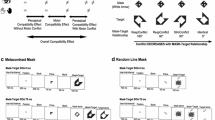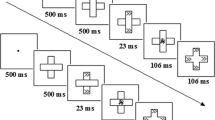Abstract
A prime even if backward masked can affect the reaction to a subsequently presented target. According to the object-updating hypothesis, negative CE (i.e. longer reactions in the compatible than incompatible trials) occurs due to the interaction between prime and a subsequent stimulus (usually a mask or flanker). Its crucial assumption is that only new elements of the mask can affect the response. As the masks are usually composed of figures that call for both possible responses, the masks’ new element calls for a response opposite to that initialized by the prime. Here an experiment is described in which the prime and target were two arrowheads pointing to left or right. Two different flankers were composed from the two heads pointing to the opposite directions. In contrast to the OU hypothesis, NCEs were different for the two flankers. This finding contradicts the OU hypothesis.


Similar content being viewed by others
Notes
One can argue that the OU hypothesis relies merely or primarily on similarity of elements or constituents comprising a configuration rather than on similarity of the (resultant) configuration. It should be, however, noted that in the present experiment, the compatibility effect should be identical for both stimuli, independently of whether the configurations or their elements matter. This is because both the novel configuration and the novel elements are identical for both flankers. Therefore, regardless of whether novel configuration or novel elements drive the participants’ response, the flanker effect should be identical.
References
Boy F, Clarke K, Sumner P (2008) Mask stimulus triggers inhibition in subliminal visuomotor priming. Exp Brain Res 190:111–116
Eimer M, Schlaghecken F (1998) Effects of masked stimuli on motor activation: Behavioral and electrophysiological evidence. J Exp Psychol Hum Percept Perform 24:1737–1747
Jaśkowski P (2007) The effect of nonmasking distractors on the priming of motor responses. J Exp Psychol Hum Percept Perform 33:456–468
Jaśkowski P (2008) The negative compatibility effect with non-masking flankers. A case for a mask-triggered inhibition hypothesis. Conscious Cogn 17:765–777
Jaśkowski P, Przekoracka-Krawczyk A (2005) On the role of mask structure in subliminal priming. Acta Neurobiol Exp 65:409–417
Jaśkowski P, Verleger R (2007) What determines the direction of subliminal priming. Adv Cognitive Psychol 3:181–192
Jaśkowski P, Białuńska A, Tomanek M, Verleger R (2008) Mask- and distractor-triggered inhibitory processes in the priming of motor responses. An EEG study. Psychophysiology 45:70–85
Lleras A, Enns JT (2004) Negative compatibility or object updating? A cautionary tale of mask-dependent priming. J Exp Psychol Gen 133:475–493
Lleras A, Enns JT (2006) How much like a target can a mask be? Geometric, spatial, and temporal similarity in priming. A reply to Schlaghecken and Eimer (2006). J Exp Psychol Gen 135:495–500
Schlaghecken F, Eimer M (2002) Motor activation with and without inhibition: evidence for a threshold mechanism in motor control. Percept Psychophys 64:148–162
Schlaghecken F, Eimer M (2006) Active masks and active inhibition: a comment on Lleras and Enns (2004) and on Verleger, Jaśkowski, Aydemir, van der Lubbe, and Groen (2004). J Exp Psychol Gen 135:484–494
Sumner P (2007) Negative and positive masked-priming—implications for motor inhibition. Adv Cognitive Psychol 3:595–604
Verleger R, Jaśkowski P, Aydemir A, Van der Lubbe RHJ, Groen M (2004) Qualitative differences between conscious and non-conscious processing? On negative and positive priming effects induced by masked arrows. J Exp Psychol Gen 133:494–515
Acknowledgments
The author is grateful to Dr. Blandyna Skalska and Ewelina Trzcińska for their help in data collection.
Author information
Authors and Affiliations
Corresponding author
Rights and permissions
About this article
Cite this article
Jaśkowski, P. Negative compatibility effect: the object-updating hypothesis revisited. Exp Brain Res 193, 157–160 (2009). https://doi.org/10.1007/s00221-008-1700-6
Received:
Accepted:
Published:
Issue Date:
DOI: https://doi.org/10.1007/s00221-008-1700-6




